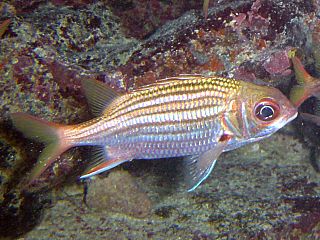The Cetomimiformes or whalefishes are an order of small, deep-sea ray-finned fish. Some authorities include the whalefishes as part of the order Stephanoberyciformes, within the superfamily Cetomimoidea. Their sister order, the Beryciformes, includes the flashlight fish and squirrelfish.

Sargocentron is a genus of squirrelfish found in tropical parts of the Indian, Pacific and Atlantic Oceans, with the greatest species diversity near reefs in the Indo-Pacific. Being largely or entirely nocturnal, they have relatively large eyes. Red and silvery colours dominate. The preopercle spines are venomous and can give painful wounds. Most have a maximum length of 15–25 cm (6–10 in), but S. iota barely reaches 8 cm (3 in), and S. spiniferum can reach more than 50 cm (20 in).

Sargocentron tiere or the blue-lined squirrelfish is one species of Squirrelfish from the Indo-Pacific. It occasionally makes its way into the aquarium trade. It grows to a size of 33 cm in length.

Sargocentron xantherythrum commonly known as Hawaiian squirrelfish or striped squirrelfish is a member of the squirrelfish family that is endemic to the Hawaiian Islands. It occasionally makes its way into the aquarium trade. It grows to a length of 17 centimeters (6.7 in).

Sargocentron diadema, known commonly as the crowned squirrelfish, is a member of the family Holocentridae in the order Beryciformes. Squirrelfish in general are large, active, nocturnal fish which are usually red in color.

The longspine squirrelfish is a silvery red, sea fish with orange-gold body stripes. One of about 150 species of squirrelfish, their most distinguishing characteristics are their large eyes and the long third spine of the anal fin. It is often included in public aquarium displays. The length of the longspine squirrelfish is about 18 cm. It lives in coral reefs in tropical and warm temperate seas and eats zoobenthos. It is territorial and uses sounds called "grunts" and "staccatos" to defend its crevice, warn of danger and, in groups, intimidate predators such as the moray eel. The longspine squirrelfish is edible and harvested on a small scale.

Holocentrus is a genus of squirrelfishes found in the Atlantic Ocean.

Neoniphon is a genus of squirrelfishes.

Sargocentron spiniferum, common name sabre squirrelfish, giant squirrelfish and spiny squirrelfish, is a large Indo-Pacific species of squirrelfish belonging to the family Holocentridae.

Holocentrinae is a subfamily of Holocentridae containing 40 recognized species and one proposed species. Its members are typically known as squirrelfish and all are nocturnal. All three genera in the subfamily are found in the Atlantic and Holocentrus is restricted to this ocean. Most species in genera Neoniphon and Sargocentron are from the Indo-Pacific region and several of these occur in the Indian Ocean west of the southern tip of India.

Sargocentron rubrum, also known as redcoat, is a member of the family Holocentridae of the order Beryciformes. Squirrelfish in general are large, active, nocturnal fish which are usually red in color.

Neoniphon opercularis, the blackfin squirrelfish, also known as the mouth-fin squirrelfish or clearfin squirrelfish, is a species of squirrelfish found in the Indian Ocean and Pacific Ocean from East Africa as far east as New Caledonia. It lives alone or in small groups in or near reefs and lagoons between 3 and 25 metres deep and can reach sizes of up to 35.0 centimetres (13.8 in) TL. It eats crabs and shrimps. Its dorsal fin is raised to scare off or startle predators. It also has a large venomous spine at the corner of its preopercle. It is relatively unaffected by commercial fishing, but is sometimes used as bait for tuna fisheries.
Neoniphon sammara, the sammara squirrelfish, also known as the blood-spot squirrelfish, slender squirrelfish, spotfin squirrelfish, armed squirrel-fish or javelin squirrelfish, is a species squirrelfish found in the Indian Ocean and Pacific Ocean from East Africa to the Hawaiian Islands. It feeds on shrimps and small crabs and fish at night and can grow up to 32.0 centimetres (12.6 in) TL in length, though its common length is only 23.0 centimetres (9.1 in) TL. Like N. opercularis, it has a venomous spine on its preopercle.

Neoniphon marianus, also known as the longjaw squirrelfish, is a species of squirrelfish found in the Western Atlantic Ocean from the Floriday Keys, USA south to Trinidad and throughout the Caribbean Sea. It lives near reefs at depths between 1 and 70 metres, usually between 30 and 60 metres, and can reach sizes of up to 18.0 centimetres (7.1 in) TL. It is nocturnal and consumes mostly shrimps, but will also eat crabs.

Sargocentron punctatissimum is a species of fish related to the squirrelfish.
Sargocentron dorsomaculatum, also known as the spotfin squirrelfish, is a species of squirrelfish found in the western Pacific Ocean near the Ryukyu Islands, Pohnpei, Kosrae, the Caroline Islands, and Palau. It lives in shallow reefs at depths between 2 and 9 metres. Like other members of its genus, it is nocturnal and seeks shelter among corals and other structures. It can reach sizes of up to 19.7 centimetres (7.8 in) SL.
Sargocentron microstoma, the fine-lined squirrelfish, slender squirrelfish or smallmouth squirrelfish, is a member of the family Holocentridae. It has a wide range throughout the Indo-Pacific from the Chagos Archipelago, Seychelles, and the Maldives to the Hawaiian Islands, Line Islands, and the Tuamotus Archipelago, north to the Ryukyu Islands and Bonin Islands, south to Austral Islands and throughout Micronesia. It lives near reefs usually at depths between 1–35 m (3.3–114.8 ft), but can be found as deep as 183 m (600 ft). During the day it hides in crevices, especially near Acropora and Pocillopora. It is a nocturnal predator, feeding on crustaceans, worms, and fishes. It can reach sizes of up to 20 cm (7.9 in) TL and has a venomous preopercle.
Neoniphon argenteus, the clearfin squirrelfish or silver squirrelfish, is a seldom-seen member of the family Holocentridae. It is native to the Indian Ocean and Pacific Ocean from East Africa to New Caledonia. It is also found both north and south of Australia and throughout Micronesia. It lives mainly around islands and shallow reefs, and like N. sammara is associated with Acropora corals. Its depth range is 3–20 m (9.8–65.6 ft) and it can reach sizes of up to 24.0 cm (9.4 in) TL. It feeds primarily on benthic invertebrates. It is found in the ornamental trade and can be used as bait in tuna fisheries, but there are currently no known major threats to the species.

Neoniphon aurolineatus, more commonly known as the yellowstriped squirrelfish or gold-lined squirrelfish, is a member of the family Holocentridae. It has a wide range throughout the Indian and Pacific Oceans stretching east from Mauritius to Hawaii and south from Japan to the Great Barrier Reef of Australia. It lives on the outer reef slopes at depths between 30 and 188 metres. It lives near the ocean floor or in caves, generally staying alone or in small groups. It feeds on crustaceans and can reach sizes of up to 25.0 centimetres (9.8 in) TL. It is listed as "Least Concern" by the IUCN due to its deep-water habitat and lack of known major threats.














